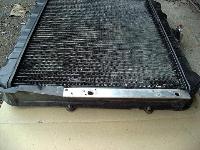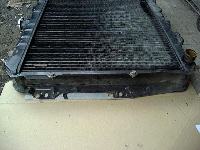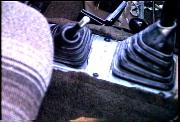Cheap Body Lift
Contents:
Back to my Cheap Tricks main page.Introduction:
A body lift is one technique used to gain extra clearance for larger tires and to lift parts of the body higher to reduce the risk of damage from obstacles on the trail. A body lift is relatively easy and inexpensive to do, has the least impact on center of gravity (compared to suspension and tire mods) and can make installation of other items easier. On the downside, it adds no extra capability to the suspension, it adds extra stress to the body mounts and may require modifications to other components.
So why did I choose to do this to my truck? Well, actually I did it in stages; first installing polyurethane body mount bushings, then slipping in a few washers for the heck of it, and then finally doing it for real. This was taking place during the time I was deciding on front and rear bumpers and rocker panel protection. By lifting the body off the frame a bit, it allowed the Rock Sliderz and rear bumper to be mounted higher than would be possible without the lift. Since these were two problem areas on a 4Runner, every inch gained makes a huge difference. I decided on 1" as the most lift I could get without serious consequences.
[Return to the top of this page]Body Mount Bushings:
When I first installed my new suspension, it seemed like a good time to replace the stock rubber body/cab mounting bushings. I installed a set of ProThane polyurethane body mounts. There are a total of 10 on my 4Runner; 5 on each side. I was actually missing the right rear bushing completely and the two front ones were badly damaged due to improper bumper installation by the previous owner.
Comparing the stock rubber bushings to the new poly ones is interesting. The rubber is cracked and soft enough to squeeze between the fingers. The poly is firm, about like a skateboard wheel.
The best way I found to do the swap is to remove the nuts on one side of the truck (also helps to remove the bolts holding the front bumper). Then, use a HiLift jack, with a 2x4 under the lip of the rear fender, to lift the bolts clear of the bushings. I had to replace the front two mounting bolts, as they had been replaced with undersized standard bolts after a fender-bender a few years ago. I found 7/16" Grade 5 or 8 bolts do the job quite nicely.
I found the second set of bolts (from the front) are not captive and you'll need to pull the carpet up, pop the plastic plug and hold the bolt with a wrench from the top while turning the nut. The other bolts are captive, but can be accessed in a similar manner. In fact, you can remove them, drive the bolts out of the captive washer and drive in a new 7/16" bolt and they hold tight. I did this so I could add aero-lock nuts to the all the bolts.
The new polyurethane body mounts are the best improvement you can do to the truck's ride. They completely eliminated the shudder and really reduced rattles. Since they tie the body to the frame much more securely, the body doesn't vibrate or shudder like it used to. And, contrary to the common misconception, polyurethane bushings are not prone to squeaking, at least as far as body mount bushings go. If you think about what it takes to make a squeak, you need two parts moving past each other repeatedly. With a properly installed body mount bushing, there should be no relative motion between the body and bushing and the bushing and frame. If there is motion, that means something is wrong, likely a loose bolt or two. If that is the case, fix the problem. After all, no motion = no sqeaking.
- Cost - body mount bushings: (available here)
-
Urethane body mounts: $95 ------------------------------ Total: $95
- Rating:

[Return to the top of this page]
Body Lift:
I needed to get a little bit of body lift for added clearance of the front and rear bumpers as well as to make room for my Rock Sliderz. I felt 1" would do the job nicely. Since nobody makes 1" body lift kits for Toyota, I decided to design my own from available hardware. I found some 3/4" standard washers at the local hardware store. They are stamped from 1/8" thick steel and measure about 2" in diameter and they cost about $0.20 each. Next, I found 3/8" galvanized pipe has an inner diameter just over 7/16" and an outer diameter a bit over 1/2". I cut 1" sections of pipe, and stacked up 8 washers on top of the body mount washer. The pipe goes in the center of the washers and I used a polyester resin/filler to cement the washers and pipe into one solid unit.
-
FWIW, the stock body mount bolts on my 4Runner appear to be M10x80
1.25mm pitch threads.
- Since my local hardware store has a larger selection of SAE fasteneres, I found 7/16" was just a bit bigger in diameter than 10mm and 80mm converts to 3.25", so I added my body lift height (1") and rounded up the the next 1/2" to select a bolt dimension of 7/16 x 4-1/2".
-
Yours may be different, I suggest finding one that is easy to get to,
pull it out and measure it.
- On my 4Runner, all the bolts were the same.
Its important to make the body lift block one solid piece, otherwise it can shift. Also, I feel the use of polyurethane body mount bushings is important with a body lift as well. The stock rubber bushings are way to soft to handle the added shearing stress of the lift and some aftermarket lift kits use no bushings at all. You end up with the body rigidly mounted to the frame which eventually leads to stress cracks in the body sheet metal.
The body lift went quite well, taking an afternoon. With my electric radiator fan, I did not need to make any changes in the engine compartment. With the stock fan, you'll have to makes adjustments to the radiator mounts in order to re-center the fan within the radiator shroud. I ended up re-mounting the radiator when I switched back to the stock fan/clutch setup.
In the above two images, you can see the piece of 1/8" x 1" flat aluminum stock, drilled and riveted to the radiator mounting flange. Then I drilled new mounting holes 1" above the stock holes (to lower the radiator) and re-installed the radiator. This places the top tank of the radiator about even with the front of the grill. My old radiator had a nice dent in top, no doubt caused by someone leaving a wrench over the tank and closing the hood. I replaced the aftermarket 2-row radiator with a new 3-row GoDan (GDI) unit for extra cooling.
Inside, I needed to nibble away some sheet metal in front of the transfer case shift lever. The lever would hit the metal in 4L and would knock it out of gear. Other than that, there is enough slack and play in all the other components to accommodate a 1" lift.
This lift ended up costing me half of an off-the-shelf body lift kit. It made it possible to install my rear bumper an inch higher than otherwise possible and also made a more secure installation for my Rock Sliderz. It also allowed my 33" tires to compress upwards an extra inch which proved useful once I softened up my springs.
One side effect of a body lift is that the stock wheel well liners no longer cover the space between the wheel well and the frame. I was missing the front left one anyway, so here's how I installed new liners to cover this gap.
NOTES:
-
This article describes the steps involved for a 1" lift
- I did my lift prior to mounting my custom front and rear bumpers and nerf bars
- If you have existing body protection, you may need to address remounting it higher for added ground clearance.
-
Popular body lift kits typically come in 2 and 3" models
- Another way to get a 1" lift, is buy a 2" kit and cut the blocks in half, but remember you also will have to buy new bolts, as the original ones will then be too long
- Or contact me, I'll make you a set of 1" or 2" or 3" tall blocks and supply the hardware you need to have it fit right the first time
-
If you are contemplating a 2" body lift, you probably have to
lengthen the hydraulic hose to the clutch slave cylinder.
-
You may also need to bend shift levers and lengthen the hoses to the
gas tank (or raise it) and possibly fiddle with the steering column.
- Automatic transmissions may require mods as well.
-
You may also need to bend shift levers and lengthen the hoses to the
gas tank (or raise it) and possibly fiddle with the steering column.
-
If you are going up 3", do all the above and then some.
- Originally, I thought 3" was too much in the way of a body lift, but guess what, I now run 3" of body lift
-
But, I used the 3"
b/l as a starting point to fix a whole host of other problems,
including:
- Gas tank too low
- Transfer case skid plate too low
- 2nd transfer case too close to the frame crossmember
- Bumpers and nerf bars too low
- (..., you get the point)
- Cost - body lift:
-
80 3/4" washers 15 12" 3/8 galv. pipe 3 Polyester filler 2 10 7/16 bolts 10 10 7/16 lock nuts 5 ------------------------------ Total: $35
- Rating:

[Return to the top of this page]
![]()
Visitor # 143754 since 28.AUG.2001
[Last updated: 22.March.2021]





